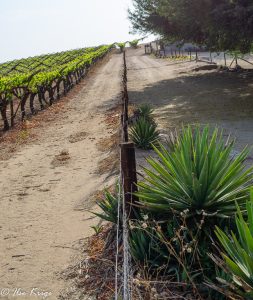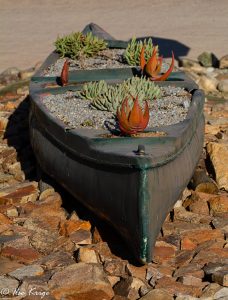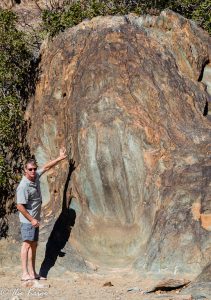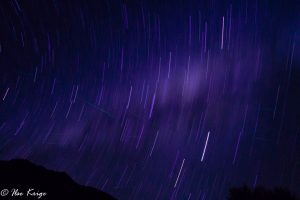19 August 2019
An unexpected visit from a friend from far away resulted in an opportunity to remove a green pin from our travel board. A green pin on the board indicates where we still want to make landfall and plant the Two Travelling Twits flag.
Jenny, a friend and ex-colleague from Stellenbosch popped in for a visit in March 2019, bringing with her the news of a planned group trip to the Richtersveld in September 2019. A throwaway remark contained an invitation for the Twits to join the jaunt. This invitation was leapt upon with alacrity, without any consideration of possible impediments in the way of such a trip – for us, from east to west right across the northern part of South Africa.
Sadly, in the months between the sealing of the travel pact and the departure date, calamity hit the prospective travelling party, with the main member and planner suffering a serious medical misfortune. His wish, however, was for the journey to continue in his and his partner’s absence.
The remaining three members agreed to meet each other at Sendelingsdrif Rest Camp at the gate of the park and then cut short the planned stays at De Hoop and Richtersberg camp sites in favour of a last night back at Sendelingsdrif.
The Twits departed from Hoedspruit on the 19th of September with gleeful cries of: “Roadtrip!”, as the journey would take us three days of relatively easy travel to reach the Richtersveld National Park. We traversed familiar ground through the JG Strydom Tunnel, over the Abel Erasmus Pass and through the towns of Ohrigstad, Lydenburg, Dullstroom and Belfast, to reach the N4 highway that would take us west towards Gauteng and the Big Smoke, Johannesburg. By the time we reached the N4, we had laid rubber on the roads of two provinces already, Limpopo and Mpumalanga.
We made a quick stop at the well-known and sprawling Alzu Petroport, just west of Belfast, where one can stand admiring groups of Sable antelope, Red Hartebeest and Ostrich in a large game enclosure while sipping your cup of delicious Mugg & Bean On The Go coffee.
As we passed into Gauteng, the third province on our route, we ogled the huge, incomplete and much lamented Khusile power station project on the side of the road close to the town of Delmas. We waved farewell to the N4 close to the Pretoria Botanical Gardens, got on the mighty N1 for a spell and in Centurion we joined the N14 that would take us west, all the way to Springbok in the Northern Cape, where we would join another great road, the N7, which takes Capetonians north, to the wonders of Namibia. We passed through the urban jungles of Gauteng at the merciful non-rush-hour-time of 11h00. While rejoicing that our travel time through the commercial heart of South Africa was blissfully brief, we also pondered the strange anomaly of calling something “rush hour”, when despite the intention of rushing, everybody is forced to move at a snail’s pace.
We were set to enter the fourth province, Northwest Province, near the town of Ventersdorp. Vast flat landscapes of closely shorn mielie (corn to non-South Africans) fields greeted us, interspersed with huge grain silos. We realised that farming is a serious business in this province.
Ventersdorp, Northwest Province. Where farming is big.
Despite the small town of Sannieshof showing the all too common signs of neglect by a municipality intent on other matters, we found a delightful lunch stop at Kontrei Koffie, a coffee-shop-cum-gift shop next to the railway station. Friendly service and generous helpings of coffee and home-made chicken pie sent us on our way, happy and satiated.
Sannieshof, Kontrei Koffie - Restaurant, Deli and Gallery
Kontrei Koffie Home Made Chicken Pie
After scooting past Baberspan and Delareyville, we arrived at Vryburg, the centre of a vast beef producing area, where we were to lay down our weary heads at the Boereplaas Holiday Resort. This turned out to be a small, well-tended resort, with a campsite, chalets, pool, restaurant and bar. We had a simple meal at the restaurant well-complimented by the most affordable bottle of red wine we have ever encountered in a restaurant and crawled into our bed early. Despite the sporadic traffic on the N18 between Stella and Vryburg, we had a good rest and were ready to leave with plenty of time to spare the next morning.
Boereplaas Holiday Resort
We entered the Northern Cape between Vryburg and Kuruman. This province remains one of my favourites, despite the same sort of neglect as in Sannieshof plaguing some of the towns. It is a vast province, with economic activities varying from area to area. Livestock farming plays a large role in the drier areas, but the future seems to be in the generation of alternate, renewable energy, with solar and wind generated electricity taking the lead. We passed immense stretches of solar panels on the road and could see wind turbines in the distance here and there.
At Kathu (Town under the Trees) we hastily polished our glasses to try and clear the red tone that spread before our eyes. No amount of glass-polishing would correct the red iron oxide dust covering everything here including the camel thorn trees that brought about the name of the town, all thanks to the Sishen mine, extracting the mineral from the bowels of the earth in five large open cast mines.
As we started running along the course of the Orange River, just east of Upington, acres of fruit plantations greeted us, mostly grapes, but also others, relying heavily on the water of the river, which is channelled inland to supply water to the settlements away from the river. The combination of available water and the dry climate makes the Northern Cape a paradise for the production of dried fruits such as raisins, sultanas and dates. In fact, Pella, a small town between the N14 and the Orange River, is the only town in South Africa that exports dates, thanks to the well-known Klein Pella date farm, run by the Karsten family.
Water Wheel, Keimoes
As on every trip we have done to this area, we stopped in Upington, the Kgalagadi Pick ‘n Pay Centre always drawing us like a magnet. Me not requiring sunglasses this time (by now a family joke), we forewent the pharmacy and opted for a light lunch at Saddles Coffee Bar and Grill instead. That is, if you can call a sizable portion of chicken schnitzel and chips at a very reasonable price a light lunch. The neighbouring Roman Catholic cathedral received some photographic attention and after a stop at the bottle store for beer and the local (rather huge) Midas for a ZA vehicle sticker, we were on our way.
Roman Catholic Cathedral, Upington
Dutch Reformed Church, Upington
Our next overnight stop was to be within kissing distance of the mighty Orange, at the farm Die Mas, on an island in the river just outside the town Kakamas. A working wine farm, the Mas offers neat chalets and camping in a peaceful, bird rich environment, right on the riverbank. Wine tasting and a river cruise are also on offer. We were slightly taken aback to hear that a wedding was to take place at the lapa function venue adjoining the camp site, but greatly relieved to hear that we had arrived a day early for the festivities, which were pencilled in for the Saturday evening. Too lazy to light a fire, we munched our way through our biltong supply and drank a few beers as the night settled around us bringing night sounds interspersed with the soothing sigh of the flowing river. We soon crawled into bed and retired to dreamland.
Vineyards at Die Mas
The next morning saw us on our way, still facing west, passing places with musical sounding names such as Bladgrond, Pofadder, Aggenys and Carolusberg. We joined the N7 at Springbok and were amazed at how the town, nestled amongst the bare granite koppies of the Klein Koperberge, had grown since our last visit (could it possibly be more than 15 years ago?). A visit to the Superspar confirmed the growth, even in my days as a city dweller, I have not seen such a large and well-stocked Spar.
Pantry replenished, we headed north for a spell before turning west again at Steinkopf on to the R382, direction Atlantic Ocean and Port Nolloth. As if to confirm that we are heading to the cold seaside of South Africa, a damp mist enveloped us as we crested the Anenous Pass just west of Steinkopf, obliterating the rocky scenery and forcing us to follow the lines in the road carefully to ensure we do not stray from the road. Luckily the misty interlude was short, and we soon emerged to a view of sparsely vegetated rocky outcroppings with their own stark beauty and variety.
At the coast, Port Nolloth, known to the indigenous people as Aukwatowa, meaning "where the water took away the old man" (https://en.wikipedia.org/wiki/Port_Nolloth), was a pleasant surprise. The town was established as a port to support the copper and diamond mining industries in the immediate area, and with these resources now mostly depleted, it has lost its initial reason for existence. However, it was tidy, and it seemed, noting a fair number of holiday homes in the town, that recreational offshore fishing at least must still be an attraction. I say this because only the brave will flock there for the pleasure of bathing in the frigid sea.
Port Nolloth Harbour
Atlantic Seaboard at Port Nolloth
From Port Nolloth, we turned north past the stark, averted cheek of the diamond mining town of Alexander Bay and headed for the South Africa-Namibia border crossing at the mouth of the Orange River (Alexander Bay/Oranjemund). This was a first for both of us, mostly because on previous visits to the area, there were restrictions to the casual entry into this diamond rich area (not called the Sperrgebiet aka Restricted Area, on the Namibian side, for nothing). After some uneventful border formalities and the payment of Namibian road tax, we were on our way again, this time east, on a well-maintained tar road bordered by sand, sand and sand. The sandy view was relieved by the results of geological turmoil and upheaval in millennia past, creating an alien landscape of outcroppings and crazily jutting ledges with colourful striations. Slightly eerie, but beautiful. On our right the Orange River meandered blithely along the sandy landscape, edged by contrasting bright green riverine growth, and on the South African side, several lively-looking productive farms.
 South Africa/Namibia Border Crossing - Alexander Bay/Oranjemund
South Africa/Namibia Border Crossing - Alexander Bay/Oranjemund
Farming in the Desert
This road joins the Namibian C13, running north to Aus, but we turned off before Rosh Pinah on a well-marked road to the Sendelingsdrif border crossing back into South Africa. We entered the Ai-Ais Richtersveld Transfrontier park and here, on the Namibian side, the stark beauty is tempered by the soft pastel hues of a sandier landscape than on the other side of the river. It was like being in a dry paradise with the road snaking into the distance between hulking hills shrouded in their best soft-coloured finery.
Ai-Ais Richtersveld Transfrontier Park, Namibian Side
Soon we were awaiting the ferry on the northern bank of the Orange River. Operated by the park, the ferry can take two vehicles at a time across the river and it deposited us at the foot of the park headquarters, a rather impressive castle-like structure. Here, a familiar-looking Landrover was parked, amazingly, we managed to time our arrival to coincide with Jenny’s. All we needed to do, was to check back though Immigration, sign into the park, stock up on firewood and ice and get settled around a campfire in the Sendelingsdrif campsite.
The Ferry over the Orange River, Sendelingsdrif
Sendelingsdrif offers the camper the last taste of luxury en route into the park, in the form of hot water showers and electricity points. There are also serviced chalets overlooking the river and a swimming pool. Further into the park the comforts become less, the camp sites on the riverbanks (Pootjiespram, De Hoop and Richtersberg) boast flush toilets and cold showers while the inland camps can only rustle up the odd dry toilet here and there, unless you choose to stay in the chalets or cabins at Tatasberg or Ganakouriep Wilderness Camps or Kokerboomkloof, where luxuries such as 12 volt lighting and flush toilets can be on offer, but water stays scarce (ensure you take ample drinking water with you). This lack of amenities should be of no concern to intrepid travellers such as the three of us, who came prepared to laugh in the face of hardship … as long as the gin and tonic did not run out!
Ablutions at Sendelingsdrif
Park Headquarters - Richtersveld National Park
Gardens, Sendelingsdrif
Cabins, Sendelingsdrif
Lolling in the lap of luxury was not the aim of the outing, so we were ready early for the trip into the park. Well, as early as the frantic search for my sunglasses would allow us (should have bought a spare pair in Upington, dammit). Finally finding it in my camp chair pocket, we rolled out to find the Hand of God.
High Five - Hand of God
Weathering over ages had caused this unique giant imprint in the shape of a six-fingered hand on the face of a rock, set in a landscape strongly reminiscent of Mordor from The Lord of the Rings, were it not for the bright blue sky and the green of the beautiful and hardy plants growing in the rocky crags. Here, the forces of nature have wrought a theatre of awe-inspiring and terrible greatness consisting of a mishmash of rock formations, from volcanic, igneous, sedimentary to metamorphic. For more information, see www. southafrica.co.za/rocks-richtersveld.html.
Jenny and Simba the Landrover in the Land of Mordor - Akkedis Pass
We continued through this photogenic landscape, over the Penkop and Akkedis Passes to the De Hoop Campsite, set against a north-flowing loop of the river at the foot of the Rooiberg. Strung along the river, it is quite a big campsite with two sets of ablutions and some shade, if you are lucky to score a site under a tree. We found a spot with its own beach and some accessible shade and set up a camp with the river flowing right past our front door. It being school holidays, the campsite was alive with visitors, something I did not expect, thinking we were going into the wild wilderness in the back of beyond. Luckily, these other campers were also of the wilderness type, quiet and in awe of nature.
Campfire, just before Sunset, De Hoop Campsite
There was plenty to keep the campers entertained. Some swam in the shallows while others floated downstream on lilos, inner tubes or just on their backs and slogged back upstream to repeat the journey, others paddled around in a variety of vessels of indeterminate water worthiness. Fishing was a favourite pastime, some immersed in the water up to their thighs and tempting the fish with elegant casts of a fly-laden line and others simply flinging out a baited hook while perched on a rock midriver. We walked a fair distance south along the river early on our first morning there and slogged back in the rising mid-morning heat, but nothing could rob the scenery of its awe-inspiring beauty, not even evidence of mining activity on the river banks or a steady stream of perspiration trickling down one’s spine.
Life on the River Banks
In the evenings, we sat around our camp fire, watching the shadows of the mountains across the river lengthen as the sun set in the west, making way for a night sky with bright stars from edge to edge and the Milky Way tracing its path across this jewelled expanse. Not to be outdone, fireflies soon started to dance out of the reeds and put on a light show of their own.
Stars and Fireflies
After two splendid, relaxing days at De Hoop, we sent off south along the river, to the Richtersberg Campsite, a smaller site, where the number of campers that can be accommodated is regulated by the level of the river, which is quite wide at this point. Fortunately, the river was at a civilised level, unfortunately the campsite was full to the brim with members of the Cape Town Landrover Club. We managed to squeeze in (our Toyota tolerated only because we were in the company of a Landrover) on a rocky spot to the side, which proved a blessing of sorts then a mean wind came up during the night, covering the other campers with river sand. However, we were not spared a restless night amidst the sound of flapping and creaking tents.
Camp Guard, on Duty, or Not ….
The next morning, our newly minted Landrover-driving friends departed on further adventures and we shifted to a more convenient campsite in one of the few shady spots. Over the past couple of days, the temperature had been climbing steadily, so we were thankful for the river and the shade.
Our two days at Richtersberg passed in a flash. It is amazing that the only thing that hurried during those two days, was time. We surely didn’t. We departed the camp, intent on a drive inland, away from the river. We were all keen to see the endemic and scarce “Halfmens” or Pachypodium namaquanum, but strangely enough, it remained elusive, only showing its distinctive fat thorny trunks and tufty crowns of leaves on the hills on the horizon. However, we came across enough examples of the white stemmed kokerboom (Aloidendron ramosissimum and Aloidendron pillansii), the fleshy spekboom (Portulacaria armiana) and other hardy plants and succulents flourishing in this hard environment where geological activities over the years have created an ideal environment for them.
Kokerboom
Botterboom
Succulent Beauty
Small Perfection
Subtle Edging
Flower Power
It needs to be mentioned that we did not see many wild animals besides baboons while we were in the park, but its is known to be home to Springbok, Klipspringer, Grey rhebok, Steenbok and Hartmann's mountain zebra. There is also a variety of reptiles and insects that have adapted to the environment. Black backed jackal and the Cape and Bat-eared foxes are present and judging by the Leopard trap next to one of the homesteads, the spotted cat has also found sanctuary in these mountains. For more info, visit www.richtersveldnationalpark.com.
Textures - This is a Dry Quiver Tree Leaf
We did have close encounters with tamer creatures such as goats (the generic variety) and sheep (an all-sorts mix) and dogs (all definitely AfriCanis or more scientifically, Canis lupus familiaris). This is because the Nama people of Richtersveld claimed title to their traditional land and have agreed to allow this section of their land to be set aside as a conservancy for future research and tourism. It was proclaimed in 1991 after years of negotiations between the National Parks Board and the local Nama people who continue to live and graze their livestock in the area.
Our route inland and back to Sendelingsdrif took us over Tatasberg and the challenging, but scenic Maerpoort Pass and kept us enthralled with the scenery where rock formations often took on shapes recognisable as everyday objects to the imaginative mind. Suffice to say, some minds in our party were more imaginative than others!
The last night at Sendelingsdrif was bittersweet, as we knew that this memorable stay in the park was at its end, however, we also felt inspired to plan more adventures, as we all agreed life was short and many places remained to be explored and discovered.
We parted ways with Jenny early the next morning, as she was intent to drive back to Stellenbosch in one go the next day while we were going to make our more leisurely way back east, and home. We opted for the gravel road on the South African side this time, and although long, windy and corrugated in places, it was not too bad.
Park Exit, Richtersveld National Park
A Wide Choice of Directions
We pumped up our tyres at a deserted petrol station in Alexander Bay, took photos at Port Nolloth, lunched at the Wimpy in Springbok and turned our noses east on the N14. We did a detour to an old favourite, the Augrabies National Park, where the Orange River thunders over the Augrabies Falls and decided to overnight there just for old-time’s sake. The restaurant at the main complex is to be recommended and we enjoyed the springbok which was soft and flavourful, rather than though and strong tasting, which can often be the case with game meat.
The Orange River at Augrabies
Viewing Platforms at Augrabies
Seating at the Pink Padstal
Quirky and Cute - The Pink Padstal
The next morning, we travelled via Kakamas and the famous Pink Padstal (coffee, photos and a bit of shopping) and past the site of Khi Solar One, just west of Upington, which confounded us for quite a few kilometres. This project consists of a solar thermal power plant driven by a solar power tower where the sun is reflected from the ground by mirrors to superheat water at the top of the tower, which then generates electricity. We saw the reflected sun on the tank at the top of the tower and thought we had stumbled on Las Vegas of the Kalahari. The truth was revealed eventually and with the help of Mr Google we learned that this kind of experimental power generation was on the up in this area.
We soon passed into the Northwest Province to Vryburg, on a Saturday, hoping to find a camping spot. The Kameelboom Lodge, looking very spruce and neat, was full of day visitors who apparently would be there until late into the night. Boereplaas looked much the same, so we continued east to find a mecca of peace at the Kameel Rust & Vrede B&B and Camping on a smallholding close to Stella. Our hosts, Patrick and Hercules, were charming and welcoming and we had a peaceful night on the grassed campsite behind their home, hearing the call of jackal from up close. We were awakened by the sounds of livestock, to remind us that we were on farming land. The lowing of cows and the crowing of roosters soon had us out of our tent to witness one of the most spectacular sunrises we had seen in a while.
Kameel Rust & Vrede B&B and Camping, Stella, NWP
Sadly, we had to get on the road again and, like horses smelling water, we were off, home. Gauteng welcomed us with a 20-minute traffic jam, on a Sunday, caused by a traffic stop on the N14 near Krugersdorp. We suspect it was for alcohol testing, but we were waved through and we could pick up speed again. From there, familiar names, towns and roads flashed past, out of Gauteng and through Mpumalanga and before we knew it, we were sailing through the tunnel to see the lowveld we love so much stretched before us. From there, it was a hop, skip and jump home where a flurry of unpacking and cleaning awaited us.
The Eastern Lowveld of South Africa, where Home is.
It is always good to get back home, but sad to know that the adventure had ended. Luckily adventure is not in short supply ……











































